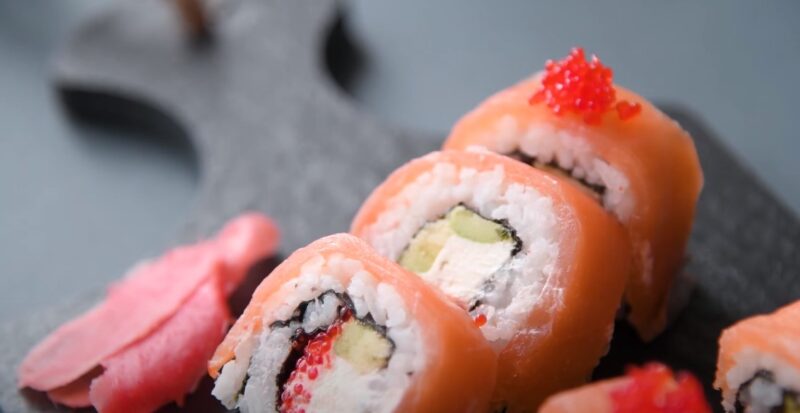The Philadelphia Roll is a sushi delicacy that marries the fresh flavors of the sea with creamy, tangy cheese. In the world of sushi, where tradition often reigns supreme, the Philadelphia Roll stands out as a Western twist on the Japanese classic.
This fusion favorite encompasses not only sushi-grade fish but also a unique blend of ingredients that create a distinct experience for the palate.
Origins and Ingredients
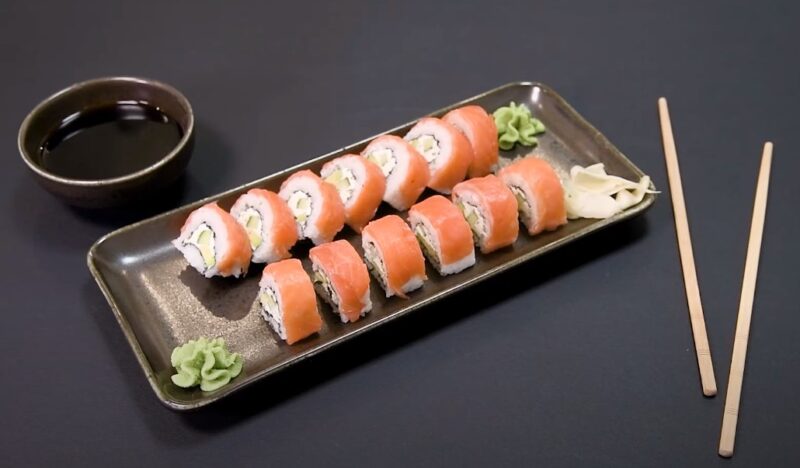
Born out of a fusion between Japanese technique and American taste, the Philadelphia Roll has quickly found its way into the hearts of sushi lovers. At its core, this roll consists of raw salmon, cream cheese, and cucumber.
Occasionally, you’ll find variations, including avocado or smoked salmon, catering to a range of preferences. It’s a simple combination, but the balance of flavors is what gives the Philadelphia Roll its mass appeal.
Preparation and Presentation
Sushi chefs create Philadelphia Rolls by spreading sushi rice on a sheet of nori (seaweed), laying down strips of cream cheese and fresh or smoked salmon, and adding cucumber for a touch of freshness.
Rolled inside-out, the rice blankets the nori, often sprinkled with sesame seeds for an extra hint of nuttiness. The roll is then sliced into bite-sized pieces, perfect for a single satisfying mouthful.
Pairings and Variations
This roll pairs beautifully with soy sauce, adding a savory depth to the tangy cheese and rich salmon. For those who enjoy a bit of heat, a dab of wasabi can bring an invigorating kick to the mix.
The versatility of the Philadelphia Roll means it can be adapted; some include scallions or substitute the cucumber with avocado for a creamier texture.
Nutritional Profile and Dietary Considerations
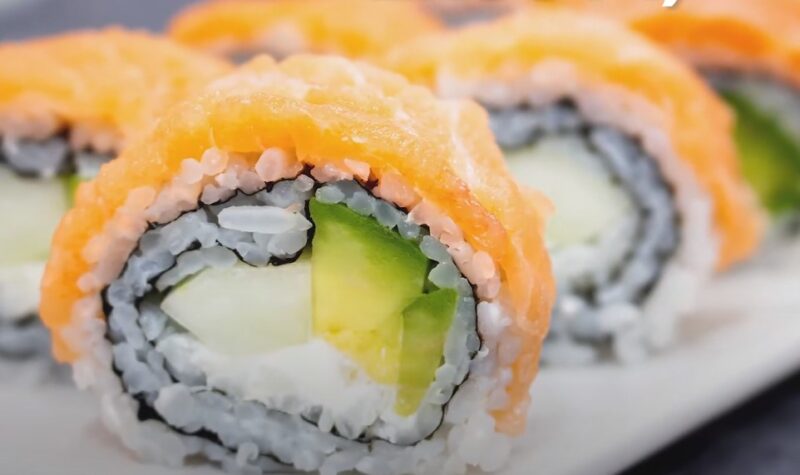
The Philadelphia Roll is not only delicious but also offers a variety of nutrients. Salmon is a great source of Omega-3 fatty acids, beneficial for heart health. Cream cheese, while more indulgent, provides a dose of calcium.
However, it’s important to consider the calorie count — a standard Philadelphia Roll can range from 250 to 300 calories per 6-8 piece serving.
Dietary Restrictions and Substitutions
Those with dietary restrictions need not miss out. Gluten-free soy sauce is available for those with gluten intolerance, and vegan cream cheese can be used as a dairy-free option.
For non-fish eaters, smoked tofu can replace salmon, making it a versatile choice for various diets.
Balance and Moderation
While indulging in a Philadelphia Roll, balance is key. Pairing it with a side of edamame or a seaweed salad can round out your meal with additional nutrients and fiber. As with all foods, enjoying sushi in moderation is part of a healthy, balanced diet.
Cultural Impact and Popularity
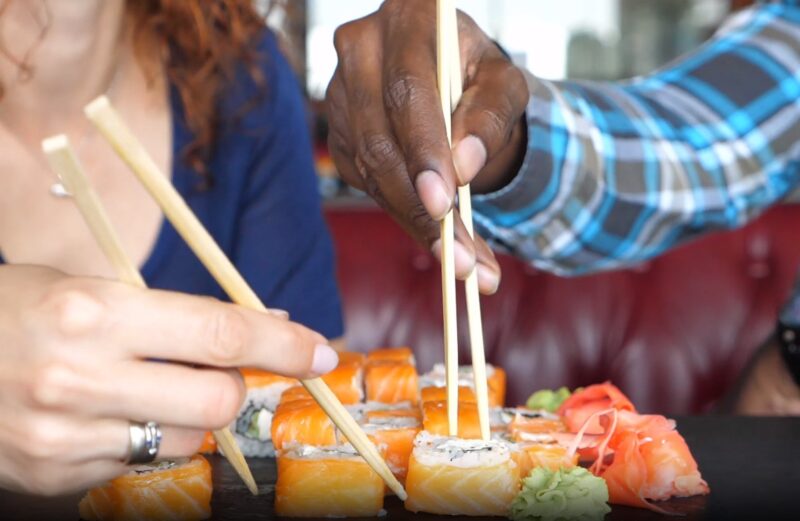
The Philadelphia Roll is a prime example of cultural culinary exchange — a Western take on traditional Japanese sushi. It exemplifies how food evolves through the blending of different food traditions, leading to innovative and delicious creations.
Its popularity has made it a staple in sushi restaurants worldwide, a testament to its widespread appeal.
The Global Sushi Craze
Sushi’s international popularity has skyrocketed over the past few decades, and the Philadelphia Roll has ridden that wave. Its beginner-friendly flavor profile makes it a go-to for those new to sushi, acting as a gentle introduction to the raw fish realm.
It’s familiar yet adventurous, a combination that has secured its place in the global sushi scene.
Making Sushi Accessible
One of the Philadelphia Roll’s biggest contributions is its role in making sushi accessible to a wider audience. By incorporating familiar ingredients like cream cheese, it has opened doors for many who might otherwise shy away from traditional sushi.
This roll demonstrates the beauty of culinary fusion and how it can bridge cultural divides through food.
Crafting the Perfect Philadelphia Roll at Home
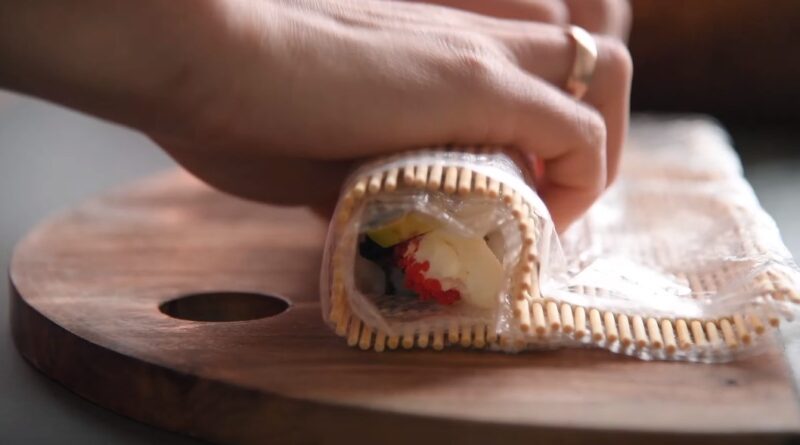
When making a Philadelphia Roll at home, the quality of ingredients is paramount. Opt for sushi-grade salmon to ensure safety and flavor, and use the freshest cream cheese for that perfect creamy texture.
Cucumbers should be crisp, and the sushi rice perfectly seasoned with the right balance of vinegar, sugar, and salt.
Rolling Technique
The art of rolling sushi may seem daunting, but with a little practice, it becomes second nature. A bamboo rolling mat is essential for getting that tight, even roll.
Cover it with plastic wrap to prevent sticking, and don’t overfill — a common mistake that can lead to messy rolls.
Presentation Tips
Cutting the roll into even pieces is crucial for presentation. A sharp knife dipped in water helps slice cleanly through the rice and fillings.
Present the pieces neatly on a platter, garnished with pickled ginger and wasabi. Remember, we eat with our eyes first, so presentation matters.
Philadelphia Roll in Popular Culture

From films to food blogs, sushi, including the Philadelphia Roll, often appears as a symbol of both sophistication and the mainstream acceptance of once-exotic cuisine.
This roll has been featured in everything from romantic comedies, where characters share a plate of sushi, to television shows highlighting the culinary arts.
Celebrity Endorsements
Several celebrities have professed their love for sushi, with the Philadelphia Roll frequently mentioned as a favorite. These endorsements have undoubtedly played a role in its popularity, making it a sought-after item at sushi bars.
Social Media and Sushi Art
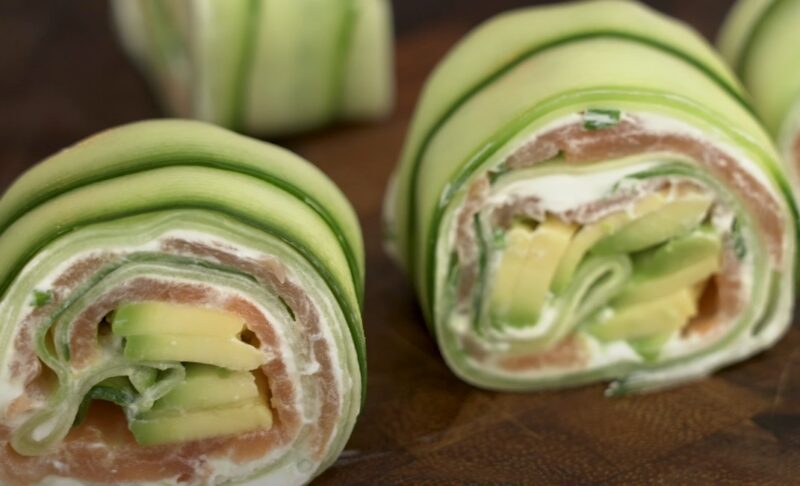
The visual appeal of sushi has made it a star on social media platforms, where the Philadelphia Roll often shines. Creative sushi chefs have turned rolling sushi into an art form, and the Philadelphia Roll lends itself well to aesthetic experimentation, resulting in some stunning, share-worthy creations.
Nutritional Table and Dietary Guide
| Ingredient | Calories (per serving) | Protein | Carbs | Fats | Notes |
| Sushi Rice | 140 | 2g | 30g | 0g | Base for the roll. |
| Nori (Seaweed) | 10 | 1g | 1g | 0g | Holds the roll together. |
| Fresh Salmon | 50 | 11g | 0g | 1g | Rich in Omega-3 fatty acids. |
| Cream Cheese | 50 | 1g | 1g | 5g | Adds creaminess. |
| Cucumber | 8 | 0g | 2g | 0g | Provides a crisp texture. |
| Sesame Seeds | 5 | 1g | 0g | 0.5g | Optional garnish. |
| Totals | 263 | 16g | 34g | 6.5g | Approximate values. |
Guide to Sushi Terminology
- Maki: Rolls of sushi with rice on the outside and nori on the inside.
- Nigiri: Hand-pressed sushi, typically with a slice of fish over a mound of rice.
- Sashimi: Sliced raw fish, served without rice.
- Wasabi: Japanese horseradish, green and pungent, usually used as a condiment.
- Gari: Pickled ginger, often served with sushi to cleanse the palate between bites.
FAQs
Can I use any type of salmon for a Philadelphia Roll?
For a Philadelphia Roll, it’s best to use sushi-grade salmon to ensure it’s safe for raw consumption. If you prefer cooked fish, smoked salmon is an excellent alternative that also adds a unique flavor profile to the roll.
Is there a low-calorie version of the Philadelphia Roll?
Yes, you can create a lower-calorie version of the Philadelphia Roll by using thin slices of cucumber as the wrap instead of rice, reducing the amount of cream cheese, or substituting it with a low-fat or fat-free version.
What is the best way to store leftover Philadelphia Rolls?
Leftover Philadelphia Rolls should be covered with cling film and stored in the coldest part of the refrigerator. It’s best to consume them within 24 hours to ensure freshness and to prevent any risk of foodborne illness.
Are there any specific drinks that pair well with a Philadelphia Roll?
Light and crisp beverages pair well with the creamy texture of a Philadelphia Roll. Green tea or a dry sparkling wine can complement the flavors nicely. For non-alcoholic options, a cucumber water or a light iced tea would be refreshing.
Can the Philadelphia Roll be considered a good source of protein?
Yes, the Philadelphia Roll can be a good source of protein thanks to the salmon, which is high in protein content. However, the amount of protein you get can vary based on the size of the roll and the ratio of fish to other ingredients.
Is it possible to make a Philadelphia Roll without seaweed?
Absolutely, you can create a seaweed-free version by using soy paper, a thin, flexible sheet made from soybeans, as an alternative to nori. Soy paper is milder in taste and can be more palatable for those who prefer not to have the distinctive taste of seaweed.
The Philadelphia Roll’s Place at the Sushi Table
It’s clear that this sushi variant has carved out a niche for itself. It brings together the zest of Western cuisine with the delicate balance of Japanese sushi, creating a menu item that’s both a comfort food and a gastronomic adventure.
Its existence is a testament to the versatility and global appeal of sushi, a dish that has transcended borders and continues to evolve. As we look towards the future, with eyes set on the next sushi innovation, the Philadelphia Roll serves as a delicious reminder of how food can connect cultures, tantalize taste buds, and inspire chefs and foodies alike.
It’s not just a roll; it’s a testament to the creativity and adaptability of the culinary world. Whether you savor it in a bustling city sushi bar or craft it carefully in your kitchen, the Philadelphia Roll is a culinary delight that’s here to stay. Also, make sure to check out our Pittsburgh food guide to learn about some famous recipes!
